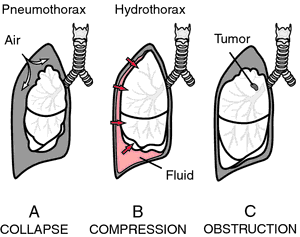Atelectasis is the collapse of part or ( much less commonly ) all of a lung.

Atelectasis is caused by a blockage of the air passages ( bronchus or bronchioles ) or by pressure on the outside of the lung.
It is common after surgery, or in patients who were in the hospital.
Risk factors for developing atelectasis include :
- Anesthesia
- Foreign object in the airway ( most common in children )
- Lung diseases
- Mucus that plugs the airway
- Pressure on the lung caused by a buildup of fluid between the ribs and the lungs ( called a pleural effusion )
- Prolonged bed rest with few changes in position
- Shallow breathing ( may be caused by painful breathing )
- Tumors that block an airway
SYMPTOMS
- Breathing difficulty
- Chest pain
- Cough
TREATMENT
The goal of treatment is to re-expand the collapsed lung tissue. If fluid is putting pressure on the lung, removing the fluid may allow the lung to expand.
The following are treatments for atelectasis :
- Clap ( percussion ) on the chest to loosen mucus plugs in the airway
- Perform deep breathing exercises ( with the help of incentive spirometry devices )
- Remove or relieve any blockage by bronchoscopy or another procedure.
- Tilt the person so the head is lower than the chest ( called postural drainage ). This allows mucus to drain more easily.
- Treat a tumor or other condition, if there is one
- Turn the person to lie on the healthy side, allowing the collapsed area of lung to re-expand
- Use aerosolized respiratory treatments ( inhaled medications ) to open the airway
- Use other devices that help increase positive pressure in the airways and clear fluids ( positive and expiratory pressure [ PEP ] devices )

PREVENTION
Measures to prevent atelectasis are related to the various causes. They include :
- If you smoke, stop.
- If you are obese, lose weight.
- If you have a chronic lung or heart condition, follow your doctor's advice for managing the disease and limiting complications.
- If you are pregnant, get prenatal care and follow your doctor's instructions.
- Try not to inhale something solid. For example, chew your food well before swallowing.
- After surgery, follow instructions for deep breathing, coughing, and turning. Ask for pain medication if discomfort is limiting movement or coughing.
No comments:
Post a Comment